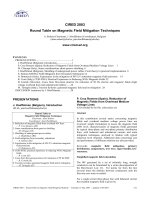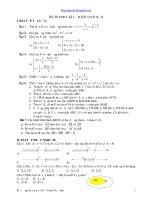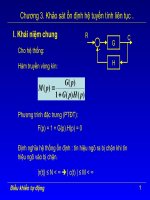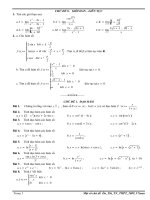Tài liệu Non-Destructive Resonant Frequency Measurement on MEMS Actuators docx
Bạn đang xem bản rút gọn của tài liệu. Xem và tải ngay bản đầy đủ của tài liệu tại đây (724.98 KB, 7 trang )
0-7803-6587-9/01/$10.00 ©2001 IEEE IEEE 01CH37167. 39
th
Annual International Reliability
99
Physics Symposium, Orlando, Florida, 2001
Non-Destructive Resonant Frequency
Measurement on MEMS Actuators
Norman F. Smith
1
, Danelle M. Tanner
1
, Scot E. Swanson
1
, and Samuel L. Miller
2
1
Sandia National Laboratories, P.O. Box 5800, MS 1081, Albuquerque, NM 87185-1081
email:
2
MEMX, Inc. 5600 Wyoming Blvd. NE, Suite 20, Albuquerque, NM 87109
A
BSTRACT
Resonant frequency measurements provide useful insight into the
repeatability of MicroElectroMechanical Systems (MEMS) manu-
facturing processes. Several techniques are available for making this
measurement. All of these techniques however, tend to be destruc-
tive to devices which experience sliding friction, since they require
the device to be operated at resonance. A non-destructive technique
will be presented which does not require the device to be continually
driven at resonance. This technique was demonstrated on a variety
of MEMS actuators.
I
NTRODUCTION
Parametric measurements are at the heart of microelectronics
manufacturing. These measurements allow the manufacturing proc-
esses to be continually monitored and corrections to be made when
necessary. Without these crucial measurements the mass production
of microelectronics would soon be impossible. The growing MEMS
industry is in need of similar parametric measurements that can pro-
vide the insight required to control these processes. This will pro-
vide the yields necessary for inexpensive mass production of micro-
systems devices.
Some of the required parametric measurements for MEMS, such
as sheet resistance, contact resistance, and electrical line width are
directly transferable from the microelectronics industry. MEMS
devices also require measurements that have no microelectronics
counterpart. Resonant frequency measurements are one of those
with no microelectronics counterpart.
Several techniques are available to measure resonant frequency.
These techniques range from manual and computer-controlled blur-
envelope techniques [1] to sophisticated electronic measurements
[2]. All of these techniques require that the device be operated at its
resonant point for a considerable length of time. Operating these
devices at resonance tends to be destructive to the device, especially
those that have sliding frictional surfaces [3]. In this paper we pres-
ent a technique that uses the viscous damping effect of the device.
This technique still requires that the device be operated for a consid-
erable amount of time. However, it does not require the device to be
driven at its resonant point which can be destructive to a mechanical
system. This technique is equivalent to plucking a taut string on a
guitar and watching the oscillation die down over a period of time.
This technique has been applied to several device types and com-
pared with blur-envelope measurements.
B
ACKGROUND
Theory
A typical MEMS actuator consists of an energy transducer (i.e.
electrostatic comb-drive, thermal expansion, etc.), an anchoring
structure, which anchors the device to the substrate, and a structure
that provides some type of restoring force to the system. An example
of a very simple actuator is shown in Figure 1. This comb-drive
system can be represented as a mass, spring, and damper system, as
shown in Figure 2. When an energy pulse is applied, all mechanical
systems of this form will exhibit some mode of damped oscillation
occurring about its natural resonant frequency. This is known as
viscously damped free vibration.
From Newton’s Law we know that SF = ma. From this we can
easily derive the homogenous form of the differential equation
0=++ xckxxm
(1)
where m is the mass of the actuator, k is the spring constant, and c is
the proportionality constant of the damper. A traditional approach to
solve this equation is to assume a solution of the form
x = e
lt
(2)
where l is a constant. The general form of the solution to the differ-
ential equation is then
tt
BeAex
21
ll
+=
.(3)
After substitution and solving for the standard form, we obtain
Figure 1. SEM image showing a simple comb-drive resonator.
m
k
c
+x
Figure 2. Schematic of a typical MEMS actuator.
100
0
2
=++
m
k
m
c
ll
.(4)
Now, we let
2
o
m
k
M=
and
@=
m
c
2
, the equation then becomes
02
22
=++
o
wdll
(5)
Solving for the roots of the equation, we obtain
22
o
wddl -±-=
(6)
Because we are solving for the case when the roots are imaginary
(Under-damped case), we can substitute
222
@MM -=-
o
. After
substitution of terms and solving for the constants in equation (3) our
solution becomes
ú
û
ù
ê
ë
é
+=
-
)sin()cos()( t
t
textx
t
o
M
@
M
@
.(7)
An under-damped system will behave similar to the function
shown in Figure 3a. One alternative case occurs when only a single
real root can be determined. This results in a critically damped sys-
tem whose behavior is shown Figure 3b.
In practice the displacement (x) is found by measuring the move-
ment from a reference point on the actuator, and t is known from the
time spacing at which the displacement measurements are taken.
The terms in equation (7), resonant frequency component (w), the
damping term (d), and the center-line displacement (X
o
), can all be
solved for by using a three parameter fit.
Data Collection System
In order to make the required displacement measurements, we
need a method to measure the movement of the device accurately and
repeatably in time. Two methods immediately come to mind. The
first method would be to use a high-speed digital camera to capture
the motion of the device in real time as the damped oscillation oc-
curs. This method allows the entire set of data to be collected during
a single actuation of the device. This method, however, is costly to
assemble. An alternative method is to use stroboscopic illumination
of the device. A stroboscopic system can be assembled relatively
inexpensively. However, a disadvantage of such a system is that the
device must be actuated many times to obtain a complete set of data.
This is due to the fact that it may require multiple actuations of the
device in order to collect a single image. For example, if the device
is driven at 480Hz and it takes 1/30 of a second to capture a frame of
video, the device will experience at least 16 actuations per image
acquired. Others [4, 5] have constructed such stroboscopic illumina-
tion systems for MEMS devices and have had very good success
with their overall operation.
The stroboscopic system used for the measurements of viscous
damping described in this paper consists of a central computer that
controls a strobe light source, waveform generator, video camera,
and digital timer circuitry. A block diagram of the system is shown
in Figure 4.
A waveform generator (not shown) is configured to output a syn-
chronized pulse that acts as a timing signal. The timing signal coin-
cides with the beginning of each waveform period. This synchro-
nized pulse is then fed into the timer circuitry, which performs a
divide-by-N function to step down the possibly multiple kilohertz
actuation signal into a range acceptable for the strobe light. This
divided signal is sent to a phase-delay circuit, which generates a
time-delayed trigger. The time delay amount is determined by the
interval at which the images are spaced. The trigger pulse is then
routed to the strobe light and optionally to the video capture card.
By adjusting the phase of the strobe light relative to the beginning of
the actuation signal, a series of images as a function in time can be
acquired. For the data presented in this paper, the image capture
-25
-20
-15
-10
-5
0
5
10
15
20
25
0 100 200 300 400 500 600 700 800
X
o
X
o
X
o
e
@t
Time
(a) Under damped system.
-10
-5
0
5
10
15
20
25
0 100 200 300 400 500 600 700 800
X
o
0
Time
0)0( >
x
0)0( =
x
0)0( <
x
(b) Critically damped system.
Figure 3. Examples of viscous damped oscillations.
Timing Signal
T
r
i
g
g
e
r
Frequency
Counter
Divide-by-N Phase Delay
Strobe Light
Camera
Video
Capture
C
o
m
p
u
t
e
r
Figure 4. Block diagram of image capture system.
101
system was configured to start image acquisitions just prior to the
actuation signal being removed from the device. The point at which
this return occurs will be referred to as the “release point”.
After the equally spaced image data are collected, displacement
needs to be determined. From the images taken, a unique search
target must be identified that can be used to determine the displace-
ment of the actuator. Ideally this target should be relatively large and
unique on the entire structure. A unique target would typically re-
quire that the actuator be redesigned or changed in some manner.
Because design changes are usually not an option, an existing feature
on the device can be used, provided it is never obscured and there are
no others like it in the defined search region.
This displacement data along with the time information are used
in a three-parameter model fit in order to determine the resonant
frequency. The parameters are iterated until the sum of the errors is
minimized. The resulting model fit yields the calculated resonant
frequency and a damping coefficient.
E
XPERIMENTAL
A
PPROACH
This technique of measuring the viscous damping stroboscopi-
cally was applied to several types of MEMS devices. Actuation
waveforms were chosen such that the initial actuation overshoot was
minimized and that the device was allowed to stabilize before the
voltage waveform drops, releasing the device from its actuated posi-
tion. A typical actuation waveform is shown in Figure 5. This wave-
form has a rising edge of 20% of the period and a 0% falling edge.
Image data were obtained on each of the devices and analyzed in a
similar manner. Blur-envelope resonance measurements were taken
on the same devices. A second operator performed the blur-envelope
measurements to avoid measurement bias in the data.
Comb Resonators
Comb-resonators as shown in Figure 1 were measured in order to
prove that this measurement concept was feasible. A total of eight
devices were measured. The devices were driven with a waveform
such as described in Figure 5. The waveform’s amplitude was set to
55 V
peak
with a frequency of 480 Hz. The design resonance point is
several kilohertz. The actuation signal was chosen to ensure that the
strobe was triggered often enough to provide an adequate amount of
light for the video camera and to be at a multiple of the camera’s
shutter speed. Magnification was chosen to fill the available field of
view. Using the smallest field of view possible allows smaller dis-
placements to be observed. This small field of view also provides a
greater range of displacement that allows a better fit to the measured
data. Since these devices did not have any unique features on them,
a repeated feature was chosen such that no other one like it would
enter the search region. The search target used for measuring the
displacements is shown in Figure 6.
A series of 250 images were taken on each resonator. Image
collection began at 175° after the start of the waveform period. The
phase-delayed trigger was then moved to capture the next image in
the time sequence. The phase-delayed trigger was allowed to re-
stabilize before the next image was taken. The strobe light required
approximately 500 ms to reacquire this new trigger. Image collec-
tion continued up to 300° from the start of the waveform period. The
images were processed using IMAQ Vision Builder [6] and the target
information was imported into Excel for final model determination.
Excel’s solver engine was used with equation (7) to solve for the
resonant frequency of the device. Model fit errors were calculated
from the sum of the square of the difference between the measured
value and the calculated value. The model fit error was then reduced
to a change in resonant frequency. The change in frequency was
determined by calculating two separate resonance curves separated
by the model fit error. A typical plot of the image data and model fit
is shown in Figure 7.
The blur-envelope measurements were made using a DC-offset
sine wave with the amplitude adjusted to achieve the maximum dis-
placement possible without the device hitting any of its mechanical
stops. The resolution for this type of resonance measurement is typi-
Actuation Pulse
0
10
20
30
40
50
60
Time
Voltage
0% Falling Edge
20% Rising Edge
“Release Point”
Figure 5. Graph of typical actuation waveform used to “pluck” de-
vice.
Search Region
Search Target
Figure 6. Resonator showing search target and region of interest.
170
180
190
200
210
220
230
0 200 400 600 800
Time (µs)
Displacement (Pixels)
Measured Data
Model Fit
Figure 7. Model fit to measured displacement data.
102
cally ±100 Hz. This is very dependent on the operator and the field
of view available.
The results comparing both types of measurements are presented
in Table 1. The damped-oscillation method shows very good corre-
lation to the blur-envelope technique. The model fit error is shown
in units of displacement squared and can be large. However, a better
indication the actual measurement error is to use the fitting error.
The fitting error shows an overall accuracy of about one percent.
One of the resonators, as shown in Figure 8, does not damp out
correctly at the end. This can cause the model fit to have a large
error value. The damping anomaly may be due to a small particle
rubbing against the moving shuttle area creating an additional
damping action for small motions. A particle is suspected since
other small particles appeared around this resonator. Even with this
large fit error, we still obtain results that are well within the meas-
urement error from the blur envelope technique.
Serial
Number
Damped
Oscillation
(Hz)
Model
Fit
Error
Fitting
Error
(Hz)
Blur
Envelope
(Hz)
2303-1 4061 120.35 ±42 4000
2303-2 4063 80.67 ±36 4100
2303-3 4003 165.81 ±33 4000
2304-1 4153 25.96 ±21 4100
2304-2 4090 108.14 ±53 4000
2304-3 4084 29.27 ±29 4000
2312-1 3681 25.82 ±22 3700
2312-3 3779 13.81 ±17 3800
Table 1. Comparison of resonance measurement methods.
A repeatability study was then performed on an additional reso-
nator. Nine separate measurements were performed on this resona-
tor. The number of images acquired was varied after every three
measurements. For each measurement, the device was removed from
the test setup and then replaced. Adjustments were made to restore
the position and focus in order to set up the part for the measurement.
Data were acquired and analyzed using the same waveform and
analysis method that was used with the individual resonators.
The resonator chosen for the repeatability studies had some of the
largest error values when compared with the other resonators used
for these experiments. The large fit errors may be due to the intro-
duction of particles or other contamination since the resonators
should be frictionless devices. A sample of the 75-point data is
shown in Figure 9. The 75-point data shows that this device is not
always periodic in its motion. This shows up as image points that are
not equally spaced in time. The non-periodicity coupled with the
sparse points during the initial oscillation period influences the
model fit equation fairly heavily. Note that the model agreement is
much better toward the end of the oscillation curve where the points
are more evenly spaced.
Measurements were repeated on this part using both 125- and
250-points. The results are presented in Table 2. The 75-point data
has a tendency to report higher resonance values than the 125- and
250 point measurements. The higher values may be due to an insuf-
ficient number of points early in the first period of oscillation. How-
ever, this measurement still falls within the measurement range ex-
pected from a blur-envelope measurement. The 125- and 250-point
measurements show reasonable agreement. This indicates that
measuring this type of resonator using only 125-points would be
sufficient to yield accurate results. The device still shows its non-
periodic motion in these images (Figure 10), but there are more
evenly spaced points giving the model a better chance at calculating
a good fit.
Points
Taken
Run Resonance
(Hz)
Model
Fit
Error
Fitting
Error
(Hz)
75 1 4347 73.64 ±72
75 2 4363 109.54 ±87
75 3 4343 85.33 ±78
125 1 4279 52.58 ±48
125 2 4295 64.91 ±52
125 3 4281 68.93 ±53
250 1 4282 160.74 ±58
250 2 4287 84.20 ±42
250 3 4292 122.05 ±51
Table 2. Repeatability for varied image points.
Sandia Microengine
The damped-oscillation measurement technique was then applied
to a different type of device. The Sandia microengine was used to
demonstrate that this technique can be used to determine a system
resonance. The microengine has been used extensively for charac-
terization and reliability studies [7, 8, 9] and its operation is fairly
well understood. The Sandia microengine consists of orthogonal
linear comb-drive actuators mechanically connected to a rotating
gear as seen in Figure 11. By applying the proper drive voltages, the
linear displacement of the comb drives is transformed into circular
160
170
180
190
200
210
220
0 200 400 600 800
Time (µs)
Displacement (Pixels)
Measured Data
Model Fit
Figure 8. Effect of additional damping component on small ampli-
tude motions.
170
180
190
200
210
220
230
0 200 400 600 800
Time (µs)
Displacement (Pixels)
Measured Data
Model Fit
Figure 9. 75-point repeatability data shows non-periodic motion.
103
motion. The X and Y linkage arms are connected to the gear via a
pin joint. The gear rotates about a hub, which is anchored to the
substrate. The Sandia microengine requires four phase-separated
drive signals for normal operation. In order to perform a resonance
measurement on the device only a single signal is required. The
acutation signal was applied to the right comb drive and the remain-
ing comb drives were grounded.
A set of three microengines was used to determine the applicabil-
ity to a more complex actuator. All three of the actuators were lo-
cated on the same die. A waveform pulse of 67.5 V
peak
was applied
to the right-left shuttle assembly on the microengine. A suitable
target was found at the connection of the support springs to the shut-
tle assembly. Data was acquired on each microengine on the die.
Since each microengine on the die is rotated 90 degrees from the
previous, it was necessary to rotate the camera when measuring in
order to measure the shuttle assembly on the same camera axis. Af-
ter the image data had been successfully acquired blur-envelope
measurements were taken. Results for the microengine experiment
are shown in Table 3.
Two of the three microengines failed during fine-tuning of the
blur image. These failures can be attributed to the fact that blur-
envelope measurements are done at the device’s resonant frequency
and can require a considerable amount of time to narrow in on the
resonant point. Operation at the resonance point has been shown to
cause the device to degrade quickly [3]. The maximum displacement
was noted to occur at approximately 1.5 kHz but further refinement
was not possible. A successful blur measurement was made on the
third microengine. The third engine’s resonant point was determined
to be 1.5-1.6 kHz. No noticeable change could be observed at these
frequencies. The amplitude began to decay at 1.4 kHz and 1.7 kHz.
The errors encountered while determining a best-fit model are
very large. After reducing this fit error to an actual change in fre-
quency, the error is still inside of the range that was measured using
the blur-envelope technique. In fact, the resonance point that was
measured using the damped-oscillation method lies almost in the
middle of where the successful blur-envelope result occurred. This
shows that the damped-oscillation resonance measurement method
can still extract very reasonable results even with large model fit
errors. The behavior of the microengine’s damped oscillation is
more closely approximated by a critically damped system (Figure 3).
This is due to the larger number of rubbing surfaces, which tend to
enhance the damping effect. Figure 12 shows the results obtained
when measuring microengine number two.
Engine
Damped
Oscillation
(Hz)
Model
Fit
Error
Fitting
Error
(Hz)
Blur
Envelope
(kHz)
1 1557 180.95 ±33 ~1.5
2 1587 400.47 ±59 ~1.5
3 1551 421.01 ±57 1.5-1.6
Table 3. Microengine resonance values.
Electrically Damped Comb-Resonators
The comb-resonator and the microengine are bi-directional de-
vices. These devices are designed to have the ability to move in
either direction past their rest position. Many devices are designed to
move in a single direction and may have mechanical stops preventing
motion in other directions. The inability to move bi-directionally can
cause the device to have inadequate room to recover correctly from
the initial cycle of the damping curve. The device may actually im-
pact its mechanical stops and prevent the continuation of the damped
motion, preventing this technique from working. However, it may be
possible to apply a constant bias to the device to move it sufficiently
away from its mechanical stops to allow the damped motion to come
to completion. Would applying a small steady state bias to a device
effect the measurement? We return to our simple comb-resonator to
find out.
170
180
190
200
210
220
230
0 200 400 600 800
Time (µs)
Displacement (Pixels)
Measured Data
Model Fit
Figure 10. 125-point data still shows evidence of non-periodic mo-
tion.
springs
shuttle
X
Y
gear
Figure 11. Sandia microengine with expanded views of the comb
drive (top left) and the rotating gear (bottom left).
270
280
290
300
310
320
330
340
0 200 400 600 800
Time (µs)
Displacement (Pixels)
Measured Data
Model Fit
Figure 12. Microengine shows a different type of damped behavior.









